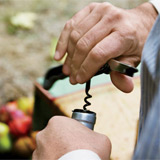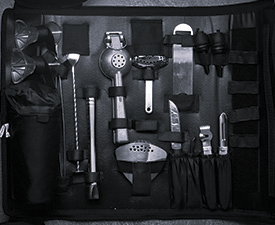The corkscrew; generally, it consists of a pointed metallic helix (often called the 'worm') attached to a handle. The user grips the handle and screws the metal point through the cork, entwining the cork and corkscrew so that moving one moves the other.
The handle of the corkscrew, allows for a commanding grip to ease removal of the cork-stopper. It is thought that the design derived from the 'gun worm' which was a device used by musket-men to remove unspent charges from a musket's barrel in a similar fashion, from at least the early 1630s.
The corkscrew is possibly an English invention, due to the tradition of beer and cider, and 'Treatise on Cider' by John Worlidge in 1676 describes 'binning of tightly corked cider bottles on their sides', although the earliest reference to a corkscrew is, 'steel worm used for the drawing of Corks out of Bottles' from 1681.
In 1795, the first corkscrew patent was granted to the 'Reverend Samuell Henshall', in England. The clergyman affixed a simple disk, now known as the 'Henshall Button', between the worm and the shank. The disk prevents the worm from going too deep into the cork, forces the cork to turn with the turning of the crosspiece, and thus breaks the adhesion between the cork and the neck of the bottle. The disk is designed and manufactured slightly concave on the underside, which compresses the top of the cork and helps keep it from breaking apart.
A 'sommelier knife' or 'waiter's friend' is a corkscrew in a folding body similar to a pocket knife. It was conceived by the German Karl Wienke in 1882 and patented in Germany, England, and America. An arm extends to brace against the lip of the bottle for leverage when removing the cork. Some sommelier knives have two steps on the lever, but take care not to chip the edge. A small hinged knife blade is housed in the handle for removing the foil wrapping around the neck of many wine bottles.










